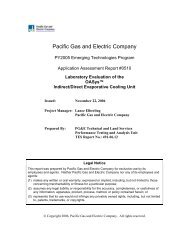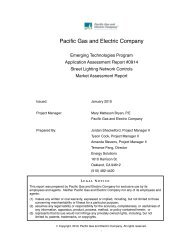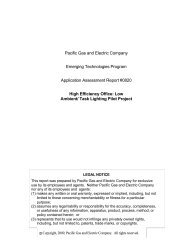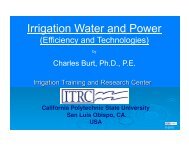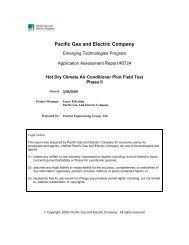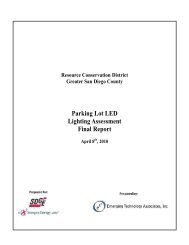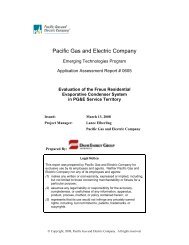PGE Water Heater ET Final Report - FINAL.pdf - Emerging ...
PGE Water Heater ET Final Report - FINAL.pdf - Emerging ...
PGE Water Heater ET Final Report - FINAL.pdf - Emerging ...
You also want an ePaper? Increase the reach of your titles
YUMPU automatically turns print PDFs into web optimized ePapers that Google loves.
PG&E’s <strong>Emerging</strong> Technologies Program <strong>ET</strong>12<strong>PGE</strong>3191<br />
of a qualified product. The program approach relies on point of purchase messaging<br />
through signage and trained salespeople that relate to targeted customers.<br />
Cost<br />
The program concept addresses consumer, PG&E, and channel costs that impact success.<br />
The consumer faces the incremental cost of the efficient water heater, which is partially<br />
offset by the PG&E rebate. Rebates and program administration are important PG&E’s<br />
costs. The retailer’s cost of participation has to be returned through increased revenue and<br />
profits. Program design levers to simultaneously address these cost concerns are rebate<br />
amount and program timing. Additionally, PG&E’s administrative costs and some of the<br />
retailer’s cost of participation can be managed by leveraging existing water heater program<br />
plans, work papers, and field services infrastructure.<br />
In the near term, a scaled down test program assesses different marketing tactics to prove<br />
market-focused concept and achieve market penetration goals. Retail channel engagement<br />
during test gets retailers’ buy-in on the concept and input on program design. Since<br />
retailers sell installation services and have relationships with plumbing contractors, lessons<br />
learned from the retail effort apply to execution of a contractor channel program. Following<br />
proof of concept, the program can be directed at additional retail segments and marketfocused<br />
design concepts can be extended to the contractor channel.<br />
BACKGROUND<br />
<strong>Water</strong> heating is a major energy use in most Californian’s homes. It accounts for 49<br />
percent of natural gas consumption and 3 percent of electricity use.<br />
California Residential Household Electricity Use California Residential Household Natural Gas Use<br />
Source: 2010 California Residential Appliance Saturation Survey, 2009 Data<br />
The installation and use of efficient electric and natural gas water heaters represents a<br />
unique and strategic opportunity for Investor-Owned Utilities (IOUs) to contribute to savings<br />
goals throughout the program cycle. Traditionally, energy efficient water heaters have been<br />
incented in the California market through downstream rebate programs, where consumers<br />
receive a rebate via mail-in application for qualifying water heater models.<br />
6



